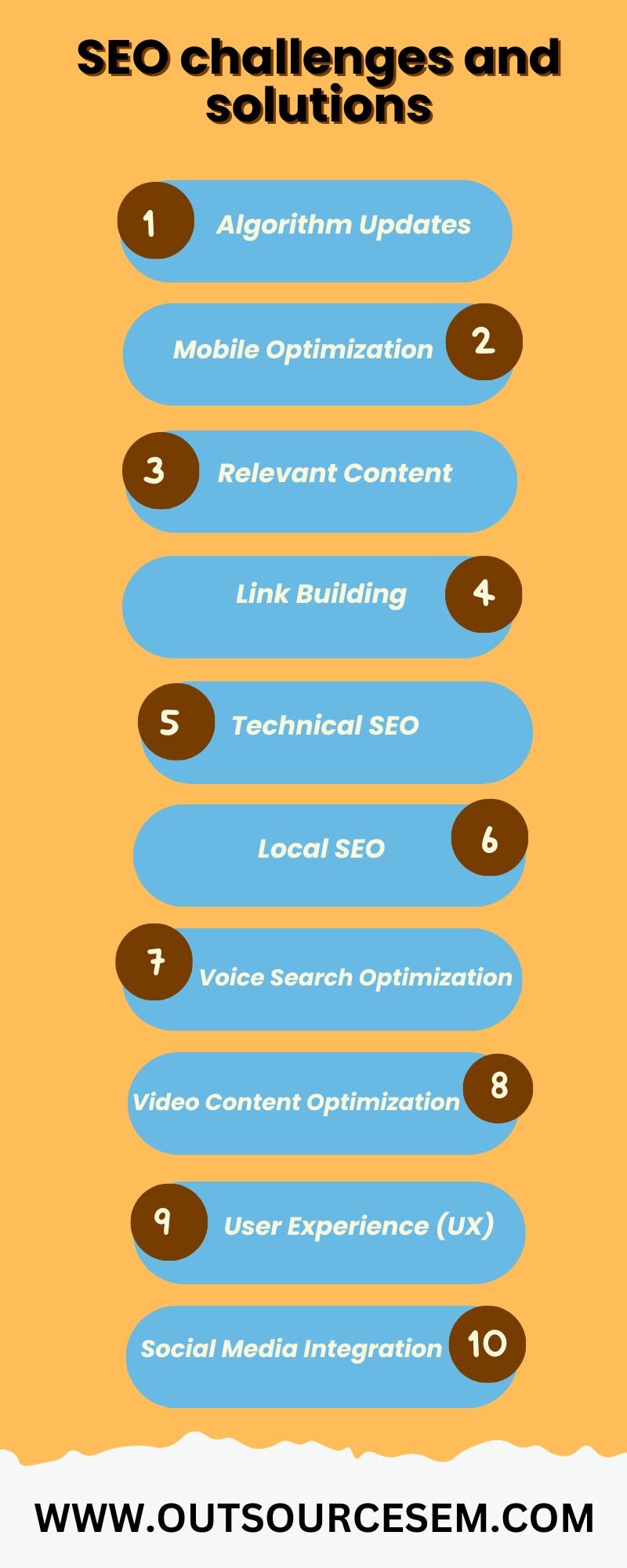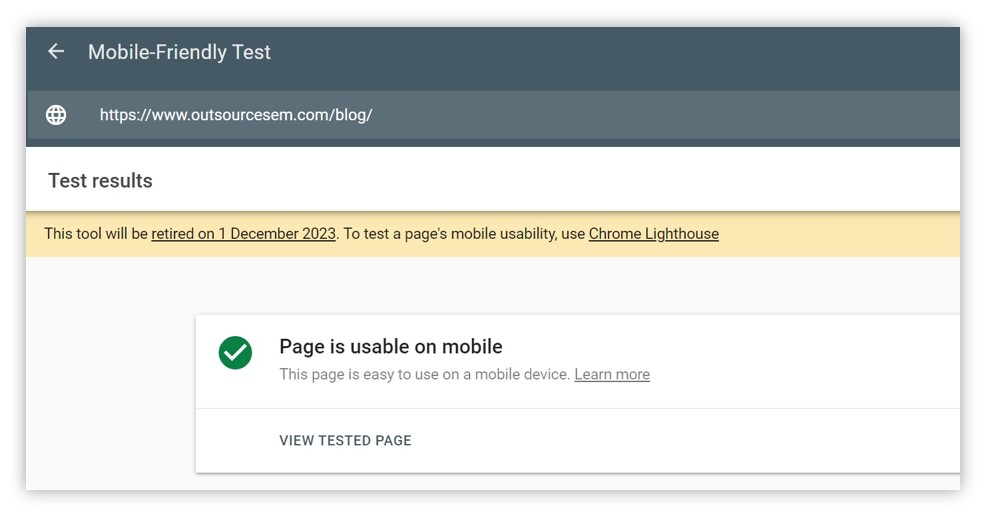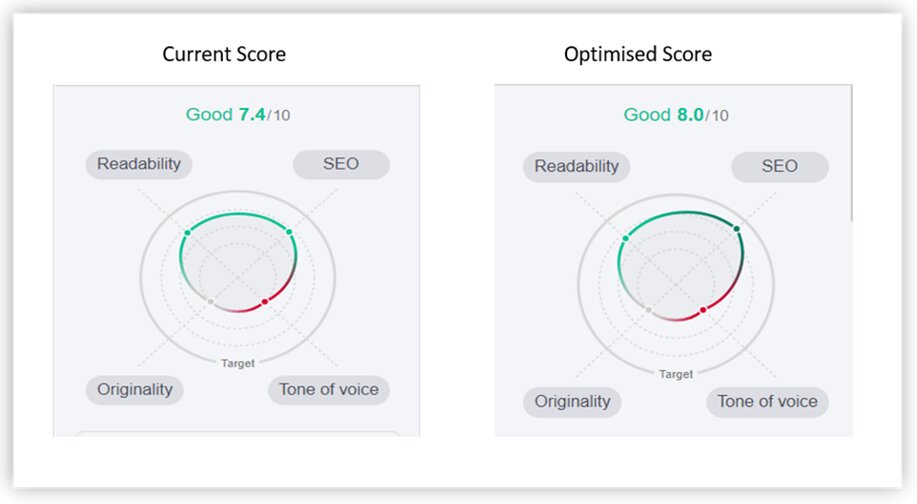Search engine optimization (SEO) is a dynamic and ever-changing field critical to a company's online success. However, as the digital landscape develops, SEO experts face many new challenges in boosting website visibility and rankings on search engine results pages (SERPs). As online marketing is different from traditional marketing, SEO marketers must keep up with the latest digital marketing trends and integrate them into their SEO plan & strategy to achieve their desired marketing goals. In this blog, we will examine some of the most common SEO problems and discuss practical solutions to achieve the desired marketing goals.

Some of the common SEO challenges and its solutions are discussed below.
1. Algorithm updates - In the ever-changing world of search engine optimization (SEO), keeping up with algorithm updates is a constant challenge. The most popular search engine - Google, updates its ranking algorithms regularly, introducing changes that can significantly impact website rankings and visibility. Because of these updates, SEO professionals must proactively adapt their strategies.
A comprehensive strategy is required to address this challenge effectively. Firstly, staying informed is critical. Maintain an active interest in industry news, subscribe to reputable SEO blogs, and participate in forums where professionals discuss the most recent developments. Utilize advanced tools designed to track algorithmic changes in real time. By combining these strategies, SEO experts can predict shifts and position themselves to quickly adjust strategies. Another effective strategy is to collaborate with peers in the industry regularly. Participating in webinars, conferences, and workshops allows for sharing ideas and experiences. This collective knowledge-sharing broadens perspectives and provides early warning signs of emerging trends, providing SEO experts with a strategic advantage.
2. Mobile optimization - The rise in mobile device usage has pushed mobile optimization to the top of the SEO priority list. Mobile-friendly websites are now prioritized in search engine rankings, making mobile optimization a non-negotiable priority for businesses looking to maintain or improve their online visibility. The solution is to adopt a responsive web design that dynamically adjusts to different screen sizes and devices. This ensures a consistent and user-friendly experience regardless of whether users access the site via desktop, tablet, or smartphone. Mobile optimization goes beyond design to include factors like page speed, critical for user satisfaction and search engine rankings.
Regular testing with tools like Google's Mobile-Friendly Test enables businesses to quickly identify and resolve issues. Furthermore, optimizing images, removing unnecessary elements, and using mobile-specific meta tags contribute to a better mobile experience. Recognizing that a positive mobile experience excites search engines and encourages user engagement and conversions is critical to SEO success.

3. Relevant content - Creating high-quality, relevant, and valuable content remains an enduring pillar in the vast landscape of SEO strategies. While maintaining consistency is challenging, businesses can overcome it using a strategic and multifaceted content approach.Thorough keyword research is essential. Understanding user intent and preferences enables businesses to tailor content to their target audience's needs. Regular content updates and optimizations ensure the content remains current and competitive in search engine rankings.
Another critical aspect is the variety of content formats. Various forms, such as videos, engaging infographics, and podcasts, cater to different user preferences while increasing reach. This not only improves the overall user experience but also helps SEO. Addressing user queries thoroughly is an essential component of content optimization. Expecting and simply answering potential questions establishes the content as a valuable resource, increasing its relevance and authority in the eyes of both users and search engines.

4. Link building - The approach to link building has undergone a transformative shift in the ever-changing landscape of SEO. Previously, the emphasis was on collecting many backlinks; however, modern search engine algorithms prioritize the quality and relevance of these links over sheer quantity. Building high-quality, authoritative backlinks is now a critical component of SEO success. A fundamental strategy is to create content that is both compelling and shareable. Content that connects with the audience and encourages organic sharing attracts valuable backlinks. Understanding the interests and needs of the target audience, creating content that adds value, and optimizing it for social sharing are all part of this process.
Another effective strategy is to build relationships with influencers and industry experts. Collaborations with influencers can result in natural and authoritative backlinks, which can increase a website's credibility in the eyes of both users and search engines. Actively participating in relevant community discussions, whether through forums or social media, helps build relationships and opens up opportunities to earn quality backlinks.
Guest blogging on reputable industry websites is still an effective strategy. By contributing insightful content to authoritative platforms, businesses can demonstrate their expertise while earning valuable backlinks. However, it is critical to approach guest blogging with authenticity and relevance, ensuring that the content is relevant to the audience of the host website and adds value.

5. Technical SEO - Technical SEO is the foundation of a website's search visibility, and crawling and indexing issues can significantly impede search engine performance. Identifying and addressing these technical issues requires a comprehensive and proactive approach. Regular website audits are required to identify potential issues. This entails inspecting the site for duplicate content, broken links, and incorrect use of canonical tags. Addressing these issues as soon as possible ensures smooth crawling and indexing. Canonicalization, or creating unique, valuable content, can be used to resolve duplicate content.
Submitting an XML sitemap to search engines is critical in enabling efficient crawling. This roadmap shows search engines the website's structure, ensuring that all relevant pages are indexed. Tools like Google Search Console and SEO crawlers speed up the detection and resolution of technical SEO issues. Regularly monitoring these tools allows businesses to avoid problems and maintain a solid technical foundation.
6. Local SEO - Local SEO is a strategic imperative for businesses with a physical presence in the digital age. Inconsistencies in business information across online platforms can confuse search engines and users. A solid local SEO strategy begins with ensuring that the business's name, address, and phone number (NAP) are consistent across online directories. Encouragement of customer reviews, especially on platforms such as Google My Business, improves local SEO and builds trust among potential customers. Responding to positive or negative reviews shows engagement and a dedication to customer satisfaction.
Local keyword optimization is critical for capturing local search traffic. This entails naturally incorporating location-specific keywords into the website's content, meta tags, and other on-page elements. Businesses should conduct extensive keyword research to determine which terms are most relevant to their local audience. Local link-building is an effective strategy for bolstering local SEO efforts. Partnerships with local businesses, sponsorship of community events, and participation in local initiatives benefit the community and generate valuable local backlinks.

7. Voice search optimization - Voice search has emerged as a transformative trend in the digital landscape, driven by the widespread adoption of voice-activated devices. Optimizing for voice search is no longer a luxury but a strategic necessity for businesses seeking to stay competitive in the ever-changing world of SEO. Voice queries are very different from text-based searches. Users' voice queries are typically phrased in a conversational and natural language style. Optimizing content for natural language queries is critical to keep up with this shift. Businesses should conduct extensive keyword research to understand the specific phrases and language voice search users use. A strategic approach to addressing common voice search queries involves anticipating users' questions and providing concise, informative responses. This corresponds to the conversational nature of voice search and positions the content as a valuable resource for users looking for quick and relevant information.
8. Video content optimization - Video content has risen to prominence as a powerful medium for communication and engagement in the age of digital dominance. Search engines have begun prioritizing video content in their search results, recognizing its popularity. Businesses must strategically optimize their video content for maximum visibility and impact to fully realize the potential of video in SEO. It is critical to optimize video titles, meta descriptions, and tags with relevant keywords for search engine recognition. Conduct keyword research to identify phrases and terms applicable to your video content and likely to be used by your target audience in search queries.
Hosting videos on popular platforms such as YouTube is a good strategy for increasing exposure, but SEO is the best practice. Brand recognition is enhanced by consistency in branding across your video content. Ensure your videos have consistent visuals, messaging, and calls to action. This promotes a unified brand image and reinforces your brand in viewers' minds.
9. User experience (UX) - The role of user experience (UX) stands out as a pivotal factor for long-term success in the intricate dance of SEO strategies. A positive and seamless user experience is critical to capturing and retaining the attention of both users and search engines, and goes beyond simple keyword optimization and rankings. Page speed optimization is critical to providing a superior user experience. Today's users expect instant gratification, and search engines recognize this by giving preference to websites that load quickly. Browser caching, minimizing server response times, and optimizing images contribute to a faster and more responsive website. Clear calls to action (CTAs) guide users through the website. Strategically placed and compelling CTAs increase user engagement, whether purchasing, filling out a form, or signing up for a newsletter. Crafting persuasive and user-centric CTAs benefits the UX and the conversion rate. The foundation of improving UX is regularly assessing user behavior using analytics tools. Tools like Google Analytics can be used to investigate user metrics such as bounce rates, time spent on pages, and conversion funnels. By determining potential pain points and areas for improvement, the website can be optimized iteratively. Understanding that a positive user experience extends beyond SEO benefits is critical. While it improves SEO by pleasing search engines, it also promotes higher conversion rates and customer satisfaction, ultimately contributing to the company's overall success and reputation.

10. Social media integration - Social media has emerged as a powerful influencer in search engine rankings in the interconnected digital ecosystem. Social signals, including likes, shares, comments, and overall engagement, significantly impact a website's visibility in search engine results pages. As a result, social media integration has become an essential component of a comprehensive SEO strategy. Creating a solid social media strategy is critical for increasing content reach and engaging with the target audience. Optimizing social profiles for relevant keywords improves visibility in social media searches and search engine results. Create concise, keyword-rich profile descriptions and ensure the company's contact information is correct and consistent across platforms.
Participating in discussions on social media platforms and industry forums is a proactive strategy. Businesses can increase their authority and visibility in their niche by sharing insights, responding to queries, and contributing meaningfully to conversations.
Conclusion
The constantly evolving field of SEO comes with challenges, but it also presents growth opportunities. By understanding the nuances of algorithm updates, prioritizing mobile optimization, creating strategic and relevant content, building authoritative backlinks, addressing technical SEO intricacies, embracing the intricacies of local SEO, focusing on user experience, and integrating social media effectively, businesses can not only overcome these challenges but also thrive in the competitive online landscape. SEO is not an overnight process, but the efforts invested can lead to long-term rewards in terms of online visibility and business growth. For your PPC ad campaigns, you focus on optimizing the performance of your paid ad in sync with the marketing trends; similarly, you need to optimize the performance of SEO campaigns. As you outsource PPC services or avail of white-label PPC services to ensure that the PPC experts optimize the ad performance, conduct PPC audits, prepare PPC reports, perform campaign analysis, etc., to maximize the advertising ROI. In the same way, you can get in touch with a digital marketing company and avail of white label SEO services. The SEO experts would conduct an SEO audit, prepare an SEO report, perform SEO keyword research, work on link building, conduct backlink analysis, etc., ultimately helping to achieve the desired marketing goals. Stay proactive, stay informed, and let your SEO strategy be a dynamic reflection of the ever-changing digital ecosystem. Conquering SEO challenges can be less challenging & effortless when you have a digital marketing agency with expert professionals available to optimize your website according to your specific needs. We offer a wide range of SEO services including painting SEO, plumbing SEO, construction SEO, appliance repair SEO, HVAC SEO, and much more.
References:
. 11 enterprise SEO challenges and solutions
. 10 common SEO challenges and their solutions
